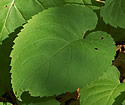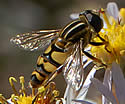Eurybia macrophylla (Large-leaved Aster)
| Also known as: | Big-leaf Aster |
|---|---|
| Genus: | Eurybia |
| Family: | Asteraceae (Aster) |
| Life cycle: | perennial |
| Origin: | native |
| Habitat: | part shade, shade; open woods |
| Bloom season: | July - October |
| Plant height: | 1 to 4 feet |
| Wetland Indicator Status: | GP: FACU MW: FACU NCNE: UPL |
| MN county distribution (click map to enlarge): |  |
| National distribution (click map to enlarge): |  |
Pick an image for a larger view. See the glossary for icon descriptions.
Detailed Information
Flower: 


![[photo of flowers]](/udata/r9ndp23q/blue/eurybia-macrophylla-large-leaf-aster_0816_130910-t.jpg) Branching clusters, typically flat-topped, of 8 to 90 stalked flowers at the top of the stem. Flowers are ½ to 1¼ inch across with 9 to 20 narrow, pale blue to violet or nearly white petals (ray flowers) irregularly spaced around the small, yellow, center disk. The disk flowers turn reddish brown with age.
Branching clusters, typically flat-topped, of 8 to 90 stalked flowers at the top of the stem. Flowers are ½ to 1¼ inch across with 9 to 20 narrow, pale blue to violet or nearly white petals (ray flowers) irregularly spaced around the small, yellow, center disk. The disk flowers turn reddish brown with age.
![[photo of bracts]](/udata/r9ndp23q/blue/eurybia-macrophylla-large-leaf-aster_0830_123507-t.jpg) Surrounding the base of a flower are hairy, appressed bracts in 4 to 6 layers. Bracts are green or tinged purple, have whitish edging, and are generally oblong with a blunt tip. Flower stalks are up to 1½ inches long, stiff and covered in short glandular hairs.
Surrounding the base of a flower are hairy, appressed bracts in 4 to 6 layers. Bracts are green or tinged purple, have whitish edging, and are generally oblong with a blunt tip. Flower stalks are up to 1½ inches long, stiff and covered in short glandular hairs.
Leaves and stems: 


![[photo of leaves]](/udata/r9ndp23q/blue/eurybia-macrophylla-large-leaf-aster_0822_155528-t.jpg) Leaves are firm, coarsely toothed, surfaces hairless to sparsely hairy and more densely hairy along major veins on the underside. Lowest leaves are large and heart-shaped, up to 8 inches long and 6 inches wide, on long stalks, becoming progressively smaller, more egg-shaped, and shorter stalked as they ascend the stem, with the uppermost leaves reduced to stalkless bracts. Flowering plants have basal leaves that wither away by flowering time; the basal leaves of non-flowering plants may persist longer.
Leaves are firm, coarsely toothed, surfaces hairless to sparsely hairy and more densely hairy along major veins on the underside. Lowest leaves are large and heart-shaped, up to 8 inches long and 6 inches wide, on long stalks, becoming progressively smaller, more egg-shaped, and shorter stalked as they ascend the stem, with the uppermost leaves reduced to stalkless bracts. Flowering plants have basal leaves that wither away by flowering time; the basal leaves of non-flowering plants may persist longer.
![[photo of winged leaf stalk]](/udata/r9ndp23q/blue/eurybia-macrophylla-large-leaf-aster_0727_132431-t.jpg) Leaf stalks are narrowly to broadly winged, becoming more pronounced as leaves ascend the stem, the middle to upper leaves often with a pair of small lobes (auricles) at the base of the stalk that clasp the stem. Stems are erect, stiff, unbranched, hairless to sparsely hairy. Plants can create sizable, dense colonies from branching rhizomes.
Leaf stalks are narrowly to broadly winged, becoming more pronounced as leaves ascend the stem, the middle to upper leaves often with a pair of small lobes (auricles) at the base of the stalk that clasp the stem. Stems are erect, stiff, unbranched, hairless to sparsely hairy. Plants can create sizable, dense colonies from branching rhizomes.
Fruit: 
Fruit is a dry seed with a tuft of dull yellowish brown to orange-brown hairs to carry it off in the wind.
Notes:
Large-leaved Aster, formerly Aster macrophyllus, is a common sight in Minnesota's woodlands and forests, the tell-tale carpet of large, heart-shaped basal leaves seen in early to mid summer a sign of things to come. The large lower and basal leaves are the most recognizable characteristic, particularly the density of any given population, and distinguish this from other blue-flowered asters that may be found in woodland habitats.
Native Plant Nurseries, Restoration and Landscaping Services ↓
More photos
 Large-leaved Aster plant
Large-leaved Aster plant Large-leaved Aster plant
Large-leaved Aster plant a dense colony of Large-leaved Aster
a dense colony of Large-leaved Aster garden-grown Large-leaved Aster
garden-grown Large-leaved Aster basal leaves in mid-summer
basal leaves in mid-summer a pollinator
a pollinator more flowers
more flowers
Photos by K. Chayka taken at Jay Cooke State Park, Carlton County, Wild River State Park, Chisago County, Iona Beach SNA, Lake County, and in Hubbard County. Photos courtesy Peter M. Dziuk taken in Lake County and his backyard garden in Ramsey County.
Comments
Have you seen this plant in Minnesota, or have any other comments about it?
on: 2011-09-17 17:19:04
I'm pretty sure this is the plant I found. I've just recently noticed them, I guess they must bllom in the fall. They are along roadsides & in peoples gardes. Very pretty.
on: 2012-05-09 13:45:54
Is it true that these plants give off a substance that inhibits the growth of nearby plants? I see it mixed with other plants in the woods, but wonder if there are certain species that can't grow near it.
on: 2012-05-10 08:15:56
Leslie, the term is alleopathy. Many plants have this trait to some degree but other species are adapted to it better than others. Big-leaf aster may be alleopathic to some other species (don't ask me which), but I don't recall ever seeing a big-leaf aster mono-culture anywhere, either. There's my unscientific observation :)
on: 2013-10-04 20:03:02
I spotted a few of these along Albert Lea Lake in September. It was a pleasant surprise since they are known for being north of the Twin Cities. They have the prettiest blue flowers on them.
on: 2014-08-18 14:56:11
I've grown A. macrophyllus from seed, but the only one blooming on 8/18/14 looks more like A. undulatus. Lower part of leaves seem to clasp the stem, as described by Peterson/McKenny field guide. These flowers are pale blue, and I thought previous year's blooms were white. Seed from Prairie Moon 2010 or before.
on: 2015-09-24 22:03:27
We have seen this plant growing along roadside and edges of ravines in Mankato. It has been particularly abundant and pretty to see these past few weeks (late September).
on: 2022-05-24 11:03:27
These were all over the forest floor at the Camp Lakamaga Girl Scout property on Big Marine Lake in Washington Co. Can't wait to go back later this summer to see them all in bloom!
on: 2023-10-26 13:28:10
Our campus had the good fortune after a buckthorn removal a couple of years ago of having a large clonal expansion of bigleaf aster that is currently shading out the buckthorn. This is currently helping in our restoration of this site.






